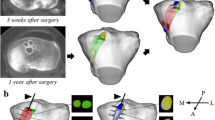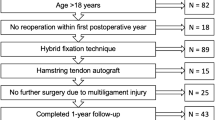Abstract
This retrospective study was designed to evaluate changes in the diameter of the tibial tunnel over time following the reconstruction of the anterior cruciate ligament (ACL) with a bone-patellar tendon-bone autograft in 44 patients. The changes in the geometry of the bone tunnels were measured radiographically during the immediate postoperative period and at time intervals between 3 and 36 months after surgery. The dimensions at 1 year were correlated with the 1-year clinical results. The distance between the sclerotic margins of the tibial tunnel was measured at the distal tunnel exis on the medial tibial cortex, in the middle of the tunnel, and proximally at the level of the joint line. The dimensions were calculated by using a magnification factor determined by reference to the interference screw of known diameter located within the tunnel. The position of the centre of the tibial tunnel with regard to Blumensaat's line was also measured. The average tunnel diameter at the proximal tibial exit increased from 12±1.9 mm (mean ± standard deviation) postoperatively to 14±2.2 mm at 3 months. The average proximal tunnel diameter did not significantly change from 3 months to 2 years, and then decreased to 13±2.4 mm at 3 years. At 1 year, most of the patterns of osteolysis were of the cone type (57%), followed by the cavity type (40%) and line type (3%). The degree of osteolysis was not related to the tibial tunnel position with respect to Blumensaat's line. There was no correlation between the changes in tunnel diameter and either the IKDC score or the residual joint laxity measured by a KT-1000 arthrometer. The aetiology of tunnel enlargement is currently unknown. Possible factors responsible for bone resorption include micromotion of the graft relative to the tunnel wall, leading to an inflammatory response in the tunnel, or stress shielding of the tunnel wall proximal to the interference screw.
Similar content being viewed by others
References
Daniel DM, Penner DA, Burks RT (1988) Anterior cruciate ligament graft isometry and tensioning. In: Friedman MJ, Ferkel RD (eds) Prosthetic ligament reconstruction of the knee. Saunders, Philadelphia, pp 17–21
Djian P, Christel P, Roger B, Witvoet J (1994) Roentgenographic and magnetic resonance imaging and anterior cruciate reconstruction using a patellar tendon graft: correlations with physical findings. Knee Surg Sports Traumatol Arthroscopy 2:207–213
Fahey M, Indelicato PA (1994) Bone tunnel enlargement after anterior cruciate ligament replacement. Am J Sports Med 22:410–414
Friederich NF, Müller W (1993) How important is isometric placement of cruciate ligament grafts: intraoperative measurement vs mid-term clinical follow-up. Rev Chir Orthop 79: Abstract 443
Fukubayashi T, Ikeda K, Fuykuoka S. Koide S (1994) Tunnel osteolysis due to Gore-Tex prosthetic ligament. In: Transactions of the 61st Annual Meeting of the American Academy of Orthopaedic Surgeons, New Orleans, p 119
Graf BK (1987) Isometric placement of substitutes for the anterior cruciate ligament. In: Jackson DW, Drez D Jr (eds) The anterior cruciate deficient knee. Mosby St Louis, pp 102–113
Howell SM, Clark JA, Farley TE (1992) Serial magnetic resonance study assessing the effects of impingement on the MR image of the patellar tendon graft. Arthroscopy 8:350–358
Jackson DW, Windler GE, Simon TM (1990) Intraarticular reaction associated with the use of freeze-dried ethylene oxide-sterilized bone-patella tendon-bone allografts in the reconstruction of the anterior cruciate ligament. Am J Sports Med 18:1–11
Linn RM, Fischer DA, Smith JP et al (1993) Achilles tendon allograft reconstruction of the anterior cruciate ligament-deficient knee. Am J Sports Med 21:825–831
Roberts TS, Drez D, McCarthy W et al (1991) Anterior cruciate ligament reconstruction using freeze-dried, ethylene oxide-sterilized, bone-patellar tendon-bone allografts: two year results in thirty-six patients. Am J Sports Med 19: 35–41
Romano VM, Graf BK, Keene JS, Lange RH (1993) Anterior cruciate ligament reconstruction: the effect of tibial tunnel placement on range of motion. Am J Sports Med 21:415–484
Author information
Authors and Affiliations
Rights and permissions
About this article
Cite this article
Peyrache, M.D., Djian, P., Christel, P. et al. Tibial tunnel enlargement after anterior cruciate ligament reconstruction by autogenous bone-patellar tendon-bone graft. Knee Surg, Sports traumatol, Arthroscopy 4, 2–8 (1996). https://doi.org/10.1007/BF01565989
Received:
Accepted:
Issue Date:
DOI: https://doi.org/10.1007/BF01565989




